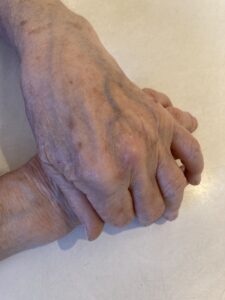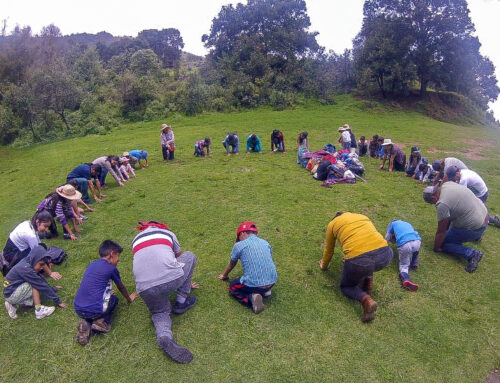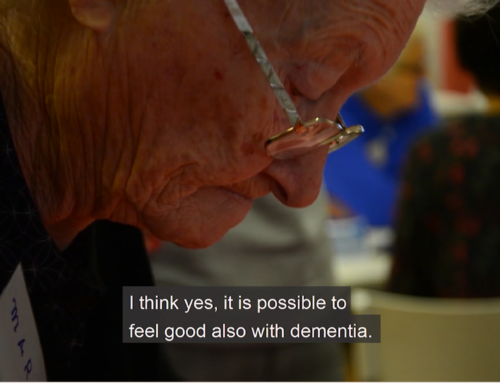1.
Bending over the kitchen table, Regina reached out with her hand and lightly touched my arm. My hand had caressed the flowery cloth next to my coffee mug. I stopped when I sensed her hand and looked up. Her grip grew a bit firmer and she cautiously squeezed the skin above my wrist. Her fingers were cool and soft. She let her hand rest and for a moment our eyes met. Like a wave, her pain rolled towards me. “It is about holding on,” she said. “One day, maybe, Candela will return.”
When I first met Regina in 1996 in Pueblo Nuevo, Central Mexico, Candela was an energetic teenager. She was the youngest of Regina’s six children, an unexpected latecomer. “You know, Julia, the last born gets all the mother’s love,” Regina explained with a smile. Her other four daughters and one son were jealous about the tenderness Candela received from their mother. A few years later, when Candela eloped with a young man from a neighboring village and crossed the border into Texas, Regina was devastated. Now in her seventies, Regina had not touched and hugged her daughter for years.
Not long after Regina had reached out and touched my arm, her husband entered the kitchen and our conversation ended. In the evening of that day in February 2023, when I sat down to write field notes, I briefly noted Regina’s pain and her longing. Then, the flow of fieldwork brought new encounters and Regina’s touch slipped my mind.
In March 2023, I returned to Germany and visited my mother. My mother is a bit older than Regina and lives alone in a small town. While we sat at my mother’s kitchen table, me listening to her, my mother suddenly reached out and touched my arm. Like Regina, she let her hand sink on my skin, leaving it there for a moment, searching for my eyes. She then spoke about the tragic loss of her younger brother, many years ago.

The author’s mother’s hands, February 2024. Photo by the author.
In the evening, I made a note to remember the felt similarity of the two gestures. I was puzzled. Obviously, the lives of the two women in their seventies, early eighties, were very different from each other. My mother is a former school teacher, living a quiet and privileged life based on a decent pension and with access to good health care. Regina is also a pensioner. But her pension is so little that, although walking is painful because of her arthritis, she sells tamales every day in front of the village’s primary school. She also suffers from asthma and diabetes, but only goes to see a doctor when one of her children helps her out with money. Still, despite these vastly different life circumstances that reflect tremendous global injustices and inequalities, I felt that there was something similar at the heart of the two gestures.
2.
Most ethnographic fieldwork is based on co-presence. During fieldwork, ethnographers constantly touch and are being touched. Nevertheless, ethnographic attention to this kind of “skinwork” (derived from Gregory’s 2011 and Tahan’s 2014 “skinship”) has only recently emerged as a more general topic of ethnographic inquiry. In 2011, Rosemary Blake wrote that touch had not been touched upon very much in anthropology. In their recent overview on touch and social interaction, Asta Cekaite and Marjorie Goodwin still find that touch remains understudied in anthropological research on sensory modality (2021, 205).
Reading anthropological work on touch, I am surprised by how intensively and fruitfully some phenomena have been researched. Much anthropological research on touch focuses on situations in which someone is in need of touch. Encounters of caring through touch have received substantial ethnographic and analytical attention. Touch is of crucial importance at the beginning of life, the care for infants and during socialization (Cekaite and Goodwin 2021, 2023). Medical anthropologists scrutinize the ambiguities of touch during medical encounters (Blake 2011; Harris 2015). At the end of life, touch and affection—and their lack—permeate anthropological research on older people. In a moving article on her mother living with progressive dementia, Janelle Taylor describes the joy she felt when engaging in touching exchanges with her mother (2008, 327). Recognizing how little touch elderly in a geriatric institution in Lima, Perú, received during her fieldwork, Magdalena Zegarra Chiappori (2019, 65; see also Playfair 2010) experienced intense feelings of sadness. Cristina Douglas’ ethnography in Scottish care facilities (2021) shows how symptoms of dementia improved when patients experienced caring atmospheres, including touching encounters with therapeutic animals, caregivers and the anthropologist. In telling detail, she describes how one patient, Ian, reached out for her and asked to hold her hand, an episode that reminds me of my touching encounters with Regina and my mother.
These ethnographies suggest that touch becomes ethnographically recognizable in extraordinary situations: birth, vulnerability, intimacy, illness, loss, death. Ethnographies on touch during pandemic times like COVID-19 or HIV/AIDS hint in similar directions (Geisler and Prince 2010; Douglas 2021). This research also emphasizes the ambiguous complexities of touch, from care to harm, from compassion to violence. The global #metoo movement has substantially increased our awareness on how widespread sexist and destructive touch can be. In their important methodological contribution on “touch biographies,” Taina Kinnunen and Marjo Kolehmainen (2019) genuinely capture how painful or hopeful their Finnish interlocutors have experienced touch during their lives.
Phenomenology has been indispensable for the anthropological understanding of touch, especially the concept of embodiment (Csordas 1990). Michael Schnegg builds on this work and suggests thinking of a situation that “touches you” as an atmosphere (2023:83; see also Douglas 2021). Following German philosopher Hermann Schmitz, Schnegg describes how being touched by an atmosphere can lead to a narrowing of the emotional space (2023, 84). These are productive thoughts for my understanding of Regina’ and my mother’s touch.
3.
Kitchen table, coffee mugs, two people sitting close to each other: a grieving mother and a listening anthropologist/daughter. These entities created an atmosphere that made our intergenerational touch possible. Additionally, memories of our previous encounters suffused the room. Only a week before, Regina and I had visited Candela’s impressive but uninhabited remittance house. Candela’s house stood among dozens of other empty houses of faraway migrants, visual reminders of painful absences (Pauli and Bedorf 2018). Regina went to the house often. “It will rot,” she explained, “when no one breathes in it.” When visiting my mother, I had looked many, many times at photographs of my deceased uncle. “He is still with me,” my mother said, touching a photo of him as a boy.
In his short story “The Death of Ivan Ilyich,” Leo Tolstoy describes the incomprehensible illness and eventual death of a successful lawyer. During the many months of his suffering, Ivan Ilyich longs to be held, longing for the touches of his childhood. But he is unable to reach out. Reaching out to someone is an act of immense courage. One can never know the other’s reaction. Regina and my mother had the courage to reach out, to touch me. What if I had withdrawn my arm? Or had looked away? The atmosphere of our kitchen table encounter encouraged the gesture. “All situations have an atmosphere that enables and constrains behavior,” writes Michael Schnegg in his treatise on loneliness in rural Namibia (forthcoming, 27). What atmospheres encourage us to reach out for each other? Across generations, genders, other potentially dividing categories? Isn’t this question crucial for our handling of these unsettling times?
References
Blake, Rosemary J. C. 2011. “Ethnographies of Touch and Touching Ethnographies: Some Prospects for Touch in Anthropological Enquiries.” Anthropology Matters 3 (1): 1-12.
Cekaite, Asta, and Marjorie H. Goodwin. 2021. “Touch and Social Interaction.” Annual Review of Anthropology 50 (1): 203-218.
Cekaite, Asta, and Marjorie H. Goodwin. 2023. “Human Touch.” In A New Companion to Linguistic Anthropology, edited by Alessandro Duranti, Rachel George, and Robin Conley Riner, 391-409. New York, West Sussex: John Wiley & Sons Ltd.
Csordas, Thomas J. 1990. “Embodiment as a Paradigm for Anthropology.” Ethos 18 (1): 5-47.
Douglas, Cristina. 2021. “A World of Touch in a No-Touch Pandemic: Living with Dementia in a Care Facility during COVID-19.” Anthropology in Action 28 (1): 8-15.
Geissler, P. Wenzel, and Ruth J. Prince. 2010. “Purity Is Danger: Ambiguities of Touch around Sickness and Death in Western Kenya.” In Morality, Hope and Grief: Anthropologies of AIDS in Africa, edited by Hansjörg Dilger and Ute Luig, 240-269. New York, Oxford: Berghahn Books.
Gregory, Chris. 2011. “Skinship. Touchability as a virtue in East-Central India.” HAU: Journal of Ethnographic Theory 1 (1): 179-209.
Harris, Anna. 2015. “Listening-Touch. Affect and the Crafting of Medical Bodies Through Percussion.” Body & Society 22 (1): 31-61.
Kinnunen, Taina, and Marjo Kolehmainen. 2019. “Touch and Affect: Analysing the Archive of Touch Biographies.” Body & Society 25 (1): 29-56.
Pauli, Julia, and Franziska Bedorf. 2018. “Retiring Home? House Construction, Age Inscriptions, and the Building of Belonging among Mexican Migrants and their Families in Chicago and Rural Mexico.” Anthropology & Aging 39 (1): 48-65.
Playfair, Catherine. 2010. “Human relationships: an exploration of loneliness and touch.” British Journal of Nursing 19 (2): 122–126.
Schnegg, Michael. 2023. “Phenomenological Anthropology. Philosophical Concepts for Ethnographic Use.” ZfE/JSCA 148: 59-144.
Schnegg, Michael. forthcoming. “Collective Loneliness: Theorizing Emotions as Atmospheres.” Current Anthropology.
Tahhan, Diana A. 2014. The Japanese Family: Touch, Intimacy and Feeling. London: Routledge.
Taylor, Janelle. 2008. “On Recognition, Caring and Dementia.” Medical Anthropology Quarterly 22 (4): 311-428.
Zegarra Chiappori, Magdalena. 2019. “Growing Old in the Margins of Perú.” Anthropology & Aging 40 (2): 60-66.
Julia Pauli is Professor of Anthropology at the University of Hamburg (Germany). Her ethnographic research in Mexico (since 1995) and Namibia (since 2003) concentrates on kinship, migration and social class.
Cite as: Pauli, Julia. 2024. Touched By: Moving Intergenerational Encounters. In “Aging Globally: Challenges and Possibilities of Growing Old in an Unsettling Era”, edited by Magdalena Zegarra Chiappori, American Ethnologist website, 7 August 2024. [https://americanethnologist.org/online-content/touched-by-moving-intergenerational-encountersby-julia-pauli/]




